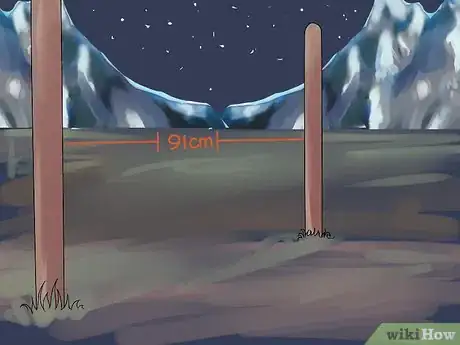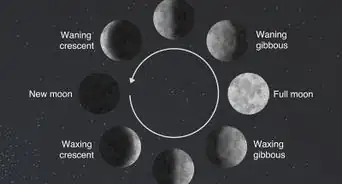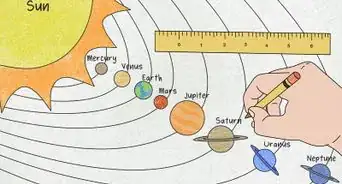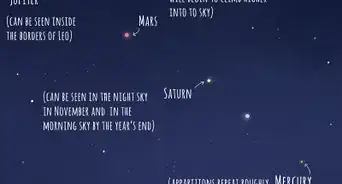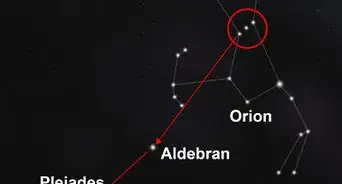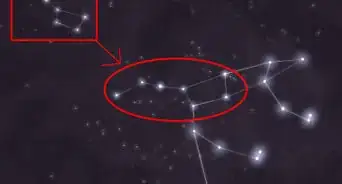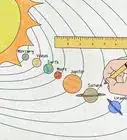wikiHow is a “wiki,” similar to Wikipedia, which means that many of our articles are co-written by multiple authors. To create this article, 19 people, some anonymous, worked to edit and improve it over time.
There are 9 references cited in this article, which can be found at the bottom of the page.
This article has been viewed 216,991 times.
Learn more...
Before the GPS, before the compass, your main means of finding your way was to navigate by the stars. Although today’s technology makes finding your way easier, it’s still fun to learn how to navigate by the stars. You can find north, south, east, or west by learning a few stars and constellations, or you can simply pick out a star and follow its movements.
Steps
Finding the North Star (Northern Hemisphere)
-
1Look for Polaris, the North Star. Polaris is the brightest star in the constellation Ursa Minor, the Little Bear. It can be found in the bear’s tail. (The ancient Greeks, and many other peoples, saw bears as having long tails.) The star is called Polaris because it appears within a degree of the Celestial North Pole and so appears not to move in the night sky. [1] [2]
- Today, because the seven stars of Ursa Minor look like a small water dipper, most people refer to Ursa Minor as the Little Dipper instead of the Little Bear.
-
2Use pointer stars to help you find the North Star. Although Polaris is visible in the northern sky at most locations north of the equator, it can be hard to spot if you don’t know exactly what you’re looking for. You can use stars in other constellations to point the way to Polaris.
- The most commonly used pointer stars are Merak and Dubhe, the two stars on the edge of the Big Dipper opposite its handle. By following these stars in the direction of the Big Dipper’s mouth, you can find Polaris. If you go five times the Merak-Dubhe distance away from Dubhe you will be within three degrees of Polaris. If Polaris is clouded over, you still know where it is.
- During the times of night when the Big Dipper is below the horizon, such as the early hours of fall, you can use another method. Find the Great Square of Pegasus. Measure the distance from Alpheratz (visually a part of Pegasus but actually part of the constellation Andromeda), to Caph, the star at the rightmost edge of the W-shaped constellation Cassiopeia. In line with Alpheratz and Caph, measure another of these distances. You will be less than three degrees from Polaris. And, like the previous method, you do not need to see Polaris. [3]
Finding Your Latitude (Northern Hemisphere)
-
1Locate Polaris. Use either of the pointer star methods to help you.
-
2Determine the angle in degrees between Polaris’ position and the northern horizon. The most accurate way to do this is with a quadrant or sextant, which lets you read the angle off its curved section. This angle measure is the same as your latitude north of the equator.
- If you don’t have a quadrant or sextant, you can approximate the angle by extending your fist to the horizon and stacking fists hand-over-hand until you reach the North Star. Your extended fist is approximately 10 degrees of angle measure.[4]
Finding South (Northern Hemisphere)
-
1Look for the constellation Orion. The constellation Orion, the Hunter, bears a resemblance to a bent hourglass. The stars Betelgeuse and Bellatrix represent its shoulders; the stars Saiph and Rigel represent its knees (or feet). The three stars in the middle, Alnitak, Alnilam, and Mintaka, represent Orion’s belt.
- In the Northern Hemisphere, Orion is visible chiefly in the winter and early spring, but can be seen late at night in the fall or before sunrise in the summer.
-
2Find Orion’s sword, if you can. Look for one moderately bright, one dim, and one fuzzy star hanging down from Alnilam, the middle star in Orion’s belt. This represents Orion’s sword, which points to the south.[5]
- The fuzzy “star” is actually the Great Nebula of Orion, an interstellar nursery where new stars are being formed.[6]
Finding South (Southern Hemisphere)
-
1Look for Crux, the Southern Cross. While there is a star near the South Celestial Pole, Sigma Octantis, it’s too dim to do you much good for finding south.[7] Instead, look for the bright constellation Crux, the Southern Cross, which consists of four stars that form the ends of the cross’ upright and crosspiece.[8]
- The Southern Cross is so important a constellation that it is depicted on the flags of Australia and New Zealand. However, it not particularly large. (It is only one degree longer than the distance between the pointer stars in the Big Dipper.) That's what makes the pointer stars (Rigel Kentaurus and Hadar) so important. They keep you from locking in on the False Cross, which is nearby and just a little bigger.
-
2Extend a line through the long axis of the cross. The point along this line, about four-and-a-half times the length of the long axis is directly above south.[9]
- (optionally) Improve your accuracy by finding the two "pointers" to the southern cross and drawing a line through them. Then take a line perpendicular from the middle of that and extend it to intersect with the line drawn from the Southern Cross. Where they intersect is directly above south.
- Drawing a line through the two stars of the crosspiece will point you to the star Alpha Centauri, the closest star to Earth after the sun.[10]
Finding Direction By Following a Star’s Position (Anywhere)
-
1Drive 2 stakes in the ground. The stakes should be about 1 yard (91 cm) apart.
-
2Pick any star you see in the night sky. You can use any star for this, although you’ll probably want to pick one of the brighter stars.
-
3Line the star up with the tops of both stakes.
-
4Wait for the star to move out of position with the stakes. Earth’s rotation from west to east causes the stars in the sky, as a whole, to rotate from east to west. Which way the star has moved with respect to its original position where you sighted it tells you which direction you’re facing.
- If the star rose, you’re facing east.
- If the star sank, you’re facing west.
- If the star moved to the left, you’re facing north.
- If the star moved to the right, you’re facing south.[12]
Community Q&A
-
QuestionHow can I find the pole star? Is it the brightest?
 Community AnswerNo, it isn't. It is, however, very bright in regard to its surroundings, making it easier to identify. The traditional way of finding it is to first locate the Big Dipper. Then, if the "handle" is on the left side, look at the two stars on the right side and imagine a line between them. Imagine this elongated four times upward (again, if the handle is on the left), and at the end of that line, there is Polaris, or the North Star.
Community AnswerNo, it isn't. It is, however, very bright in regard to its surroundings, making it easier to identify. The traditional way of finding it is to first locate the Big Dipper. Then, if the "handle" is on the left side, look at the two stars on the right side and imagine a line between them. Imagine this elongated four times upward (again, if the handle is on the left), and at the end of that line, there is Polaris, or the North Star. -
QuestionHow do I find my latitude if I can't see Polaris?
 Community AnswerMeasure the angle of the sun above the horizon at its highest point (i.e. midday). Then use a table of corrections to add or subtract the appropriate number of degrees depending on which day of the year it is (at an equinox the corrections are zero, at a solstice you add or subtract 23.5 degrees).
Community AnswerMeasure the angle of the sun above the horizon at its highest point (i.e. midday). Then use a table of corrections to add or subtract the appropriate number of degrees depending on which day of the year it is (at an equinox the corrections are zero, at a solstice you add or subtract 23.5 degrees).
Warnings
- The instructions for finding directions using reference stars will gradually become dated due to the precession of Earth’s axes, which changes the direction in which the planet’s north and south poles point. This will cause different stars to move closer to the Celestial North and South Poles. Polaris will only be the North Star for another thousand years, as the Celestial North Pole moves in the direction of the constellation Cepheus. Then the title of North Star will be taken over by Gamma Cepheus (Errai). It will be about 1.8 degrees from true north at its closest, and not nearly as bright as Polaris, but it'll be the best that we will have. [16] The instructions for finding your direction by following a star’s position over time will still work as long as Earth continues to rotate west to east.⧼thumbs_response⧽
References
- ↑ http://mentalfloss.com/article/52041/how-navigate-stars
- ↑ http://www.naturalnavigator.com/find-your-way-using/stars
- ↑ Star Identification. Naval Air Training Command, Navigation Section, January 1951.
- ↑ http://www.naturalnavigator.com/find-your-way-using/stars
- ↑ https://en.wikipedia.org/wiki/Orion's_Sword
- ↑ https://en.wikipedia.org/wiki/Orion_Nebula
- ↑ http://www.crystalinks.com/precession.html
- ↑ http://mentalfloss.com/article/52041/how-navigate-stars
- ↑ http://www.abc.net.au/science/articles/2009/07/27/3169018.htm
- ↑ Star Identification. Naval Air Training Command, Navigation Section, January 1951
- ↑ http://mentalfloss.com/article/52041/how-navigate-stars
- ↑ http://mentalfloss.com/article/52041/how-navigate-stars
- ↑ http://mentalfloss.com/article/52041/how-navigate-stars
- ↑ http://www.space.com/5849-navigating-stars.html
- ↑ Star Identification. Naval Air Training Command, Navigation Section, January 1951
- ↑ http://www.crystalinks.com/precession.html
About This Article
To navigate by the stars, try locating the North Star. Also known as Polaris, it is the brightest star in the constellation Ursa Minor, or the Little Bear. You’ll find it in the tail. Once you can see the North Star, you know that you’re facing north and can work out other directions. Alternatively, work out which direction you’re facing by using any star you like. First, drive 2 stakes into the ground and line up your chosen star with the tops of the stakes. Wait for the star to move, which happens due to Earth’s rotation. If the star rises, your facing east, but you’ll be facing west if it falls. If it moves to the left, you’re facing north, and you’ll be facing south if it moves to the right. For tips on how to calculate your latitude using the stars, keep reading!








